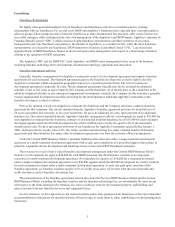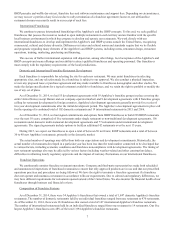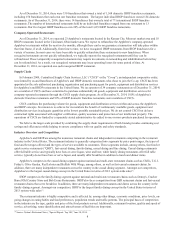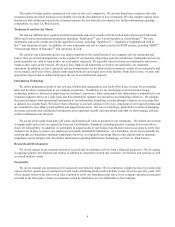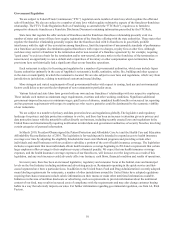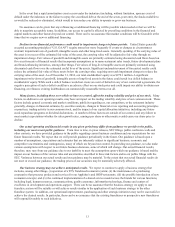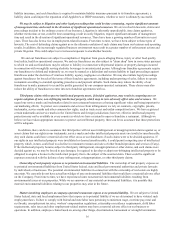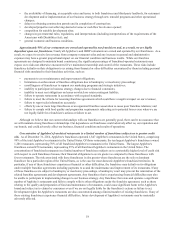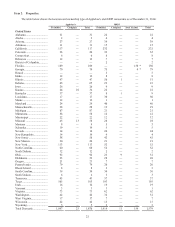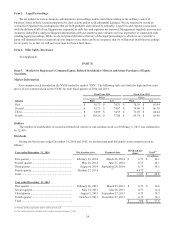IHOP 2014 Annual Report Download - page 33
Download and view the complete annual report
Please find page 33 of the 2014 IHOP annual report below. You can navigate through the pages in the report by either clicking on the pages listed below, or by using the keyword search tool below to find specific information within the annual report.14
Our performance is subject to risks associated with the restaurant industry, including the highly competitive nature of
the industry. We derive a substantial portion of our revenues in the form of royalties based on a percentage of the gross sales
of our franchised restaurants. Sales and profitability of these restaurants and, in turn, payments we receive from our
franchisees may be negatively impacted by a number of factors, some of which are outside of our control. The most significant
are:
• declines in comparable-restaurant sales growth rates due to: (i) failing to meet or adequately adapt to changing
customers' expectations for food quality and taste or to innovate new menu items to retain the existing customer base
and attract new customers; (ii) competitive intrusions in our markets; (iii) opening new restaurants that cannibalize the
sales of existing restaurants; (iv) failure of national or local marketing to be effective; (v) weakening national, regional
and local economic conditions; and (vi) natural or man-made disasters or adverse weather conditions;
• negative trends in operating expenses such as: (i) increases in food costs including rising commodity costs;
(ii) increases in labor costs including increases mandated by minimum wage and other employment laws, immigration
reform, the potential impact of union organizing efforts, increases due to tight labor market conditions and the Patient
Protection and Affordable Care Act; and (iii) increases in other operating costs including advertising, utilities, lease-
related expenses and credit card processing fees;
• the highly competitive nature of the restaurant industry with respect to, among other things: (i) price, service, location,
personnel and the type and quality of food; (ii) the trend toward convergence in grocery, deli and restaurant services,
as well as the continued expansion of restaurants in the breakfast daypart; and (iii) the entry of major market players in
non-competing industries into the food services market which could decrease the market share of Applebee’s and
IHOP in their respective categories;
• the inability to open new restaurants that achieve and sustain acceptable sales volumes;
• the inability to increase menu pricing to offset increased operating expenses;
• failure to effectively manage further penetration into mature markets;
• negative trends in the availability of credit and in expenses such as interest rates and the cost of construction materials
that will affect our ability or our franchisees' ability to maintain and refurbish existing restaurants;
• the inability to manage our company-owned restaurants due to unanticipated changes in, or availability of, qualified
restaurant management, staff and other personnel; and
• the inability to operate effectively in new and/or highly competitive geographic regions or local markets in which we
or our franchisees have limited operating experience.
A lack of availability of suitable locations for new restaurants or a decline in the quality of the locations of our current
restaurants may adversely affect our sales and results of operations. The success of our restaurants depends in large part on
their locations. As demographic and economic patterns change, current locations may not continue to be attractive or profitable.
Potential declines in neighborhoods where our restaurants are located or adverse economic conditions in areas surrounding
those neighborhoods could result in reduced sales in those locations. In addition, desirable locations for new restaurant
openings or for the relocation of existing restaurants may not be available at an acceptable cost when we identify a particular
opportunity for a new restaurant or relocation. Additionally, restaurant revitalization initiatives may not be completed as and
when projected and may not produce the results we expect.
We may experience shortages or interruptions in the supply or delivery of food and other products from third parties or
in the availability of utilities. Our franchised and company-operated restaurants are dependent on frequent deliveries of fresh
produce, food, beverage and other products. This subjects us to the risk of shortages or interruptions in food and beverage
supplies which may result from a variety of causes including, but not limited to, shortages due to adverse weather, labor unrest,
political unrest, terrorism, outbreaks of food-borne illness, disruption of operation of production facilities, the financial
difficulties, including bankruptcy, of our suppliers or other unforeseen circumstances. Such shortages could adversely affect our
revenue and profits. The inability to secure adequate and reliable supplies or distribution of food and beverage products could
limit our ability to make changes to our core menus or offer promotional "limited time only" menu items, which may limit our
ability to implement our business strategies. Our restaurants bear risks associated with the timeliness of deliveries by suppliers
and distributors as well as the solvency, reputation, labor relationships, freight rates, prices of raw materials and health and
safety standards of each supplier and distributor. Other significant risks associated with our suppliers and distributors include
improper handling of food and beverage products and/or the adulteration or contamination of such food and beverage products.
Disruptions in our relationships with suppliers and distributors may reduce the payments we receive from our franchisees or
our pancake and waffle dry mix distributors or the profits generated by our company-operated restaurants. In addition,
interruptions to the availability of gas, electric, water or other utilities may adversely affect our operations.



